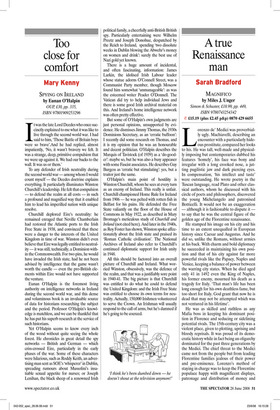A true Renaissance man
Sarah Bradford
MAGNIFICO by Miles J. Unger Simon & Schuster, £18.99, pp. 449, ISBN 9780743254342 ✆ £15.19 (plus £2.45 p&p) 0870 429 6655 Lorenzo de’ Medici was proverbially ugly. Machiavelli, describing an encounter with a particularly hideous prostitute, compared her looks to his. He was tall, well-made and physically imposing but contemporaries dubbed his features ‘homely’, his face was bony and irregular with a long crooked nose, a jutting pugilistic jaw and dark piercing eyes. In compensation, ‘his intellect and taste’ were outstanding. He wrote poetry in the Tuscan language, read Plato and other classical authors, whom he discussed with his circle of poets and philosophers, discovered the young Michelangelo and patronised Botticelli. It would not be an exaggeration — although it is fashionable to dispute it — to say that he was the central figure of the golden age of the Florentine renaissance.
He stamped his image on his city and his time to an extent unequalled in European history since Caesar and Augustus. And he did so, unlike the Romans, without armies at his back. With charm and bold diplomacy he succeeded in maintaining his own position and that of his city against far more powerful rivals like the Papacy, Naples and Venice, keeping a balance of power between the warring city states. When he died aged only 41 in 1492 even the King of Naples, his former enemy, mourned his death as a tragedy for Italy. ‘That man’s life has been long enough for his own deathless fame, but too short for Italy. God grant that now he is dead that may not be attempted which was not ventured in his lifetime’.
He was as skilled and ruthless as any Mafia boss in keeping his dominant position in Florence and seducing or sidelining potential rivals. The 15th-century city was a violent place, given to plotting, uprising and bloody reprisals. It was proud of its democratic history while in fact being an oligarchy dominated for the past three generations by the Medici. The chief threat to the Medici came not from the people but from leading Florentine families jealous of their power and pre-eminence. Lorenzo’s method of staying in charge was to keep the Florentine populace happy with magnificent displays, patronage and distribution of money and offices. Medici power was originally based on the wealth of their banking system with offices in the main commercial centres of Europe. They were the Pope’s bankers (one of the advantages of this being that they could deploy the threat of excommunication to force their clients to pay their debts). Lorenzo, although a brilliant businessman, was a hopeless banker and employed some notable incompetents as managers of his branches. For him, political considerations came before financial ones and, like other autocrats before and since, he was not above embezzling his relatives’ money to support his magnificence. He survived several attempts on his life, notably during the Pazzi conspiracy of 1478, which involved the Pope, the King of Naples and the Duke of Urbino, when his brother Giuliano was murdered beside him as they attended mass in the Duomo. Unger’s lurid description of the horrible vengeance exacted on the conspirators makes for gripping reading.
This brilliant book is almost as much the biography of a city as of a man; one of its strengths is an ability to convey the cultural, political and sexual ambience of 15th-century Florence with a rare clarity. The author explains how the passion for pagan classical myth of Lorenzo and the brilliant scholars, poets and artists with whom he liked to surround himself did not involve a rejection of Christianity: the search for God was an important part of Lorenzo’s spiritual life, and, like all Florentines, he was a member of the religious confraternities whose utterances and practices (including flagellation) would not have been out of step with the ferocious preaching of Savonarola. Membership of a confraternity was for Florentines like belonging to branches of political parties with all their opportunities for plotting and ‘networking’.
It was not, however, just religion and politics: Florence was notorious throughout Europe for ‘unnatural sexual acts’. Sodomy was common to Florentines of all classes, and although Lorenzo was predominantly and energetically heterosexual, Unger thinks it likely that he had sexual relations with some of his male friends.
Poetry and love were important to Lorenzo in countering his tendency to depression. Power alone could not bring contentment. His ambition was to make ‘himself and his city great’ Machiavelli wrote. There was a sense in which all this magnficence, this patronage of art and architecture, was fuelled by a desire to be seen as the equal of all the dukes, kings and nobles of his age. The Medici had gone from peasants to powerbrokers in just over three generations, but they remained in their own eyes ‘nouveaux’.
Miles J. Unger has made impressive use of all the latest sources and this rich, wellwritten book should be essential reading for anyone who is interested in the golden age of the Florentine renaissance, in Italian history of the period and, of course, in Lorenzo himself.



















































































 Previous page
Previous page